If your account is below 1 million and you want to make a profit in the short term, there is indeed a timeless trading method in the crypto world.
This is also a repeatedly effective 'foolproof technique' that retail traders can easily adopt; pure content!
You don't have to worry about whether you can learn; if I can seize this opportunity, so can you. I'm not a god, just an ordinary person.
The difference between others and me is that others overlook this method. If you can master this method, it will significantly improve your trading process.
In theory, this could help you earn an extra 3 to 10 percentage points of profit every day.
1. Invest in batches: Suppose you have 10,000 yuan, divide it into five parts, and use only 2,000 yuan for each trade.
2. Test the waters of investment: Start by buying a coin with 2000 yuan to see how it goes.
3. Add to positions after a drop: If the coin price drops by 10%, use 2,000 yuan to add to your positions.
4. Take profits when it rises: If the coin price rises by 10%, promptly sell part to lock in profits.
5. Repeated cycles: Keep buying and selling until funds run out or coins are sold out.
Strategic Advantage: The benefit of this strategy is that even if the coin price falls, you can remain calm. By buying in batches, you avoid the risk of a one-time investment. Even if the coin price drops by half, you only incrementally increase your holdings. And each time you sell, you can lock in a profit of 10%.
For example, if you have 100,000 yuan and invest 20,000 yuan each time, you can earn 2,000 yuan each time.
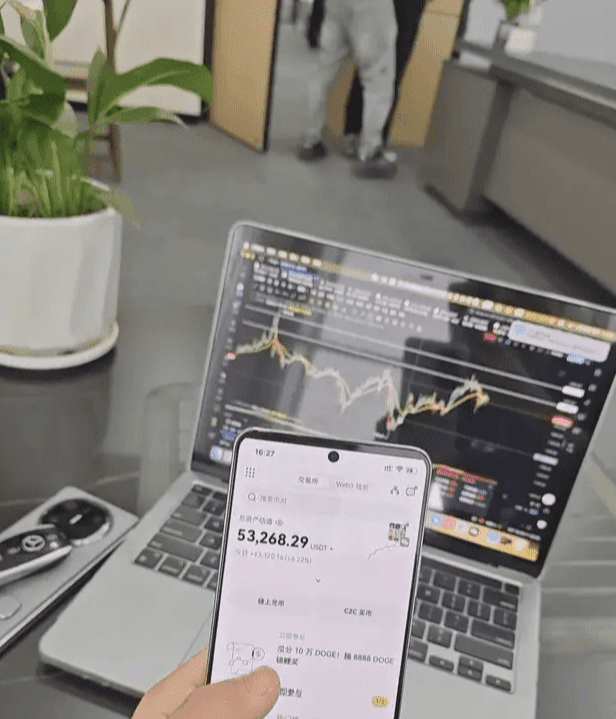
Seven life-saving cryptocurrency trading tips I learned from losing a million! A must-read for novices; I recommend saving this!
Having navigated the crypto world for years, I've experienced the despair of liquidation and the joy of doubling my investments. Today, I share the lessons learned from real trading experiences.
I hope to share this with everyone; I hope it can help even one person! I suggest liking and saving it first to avoid not finding it later~
1. Choose the right trading time; avoid daytime 'pitfalls'.
The daytime crypto world is like a 'information melee'! False good news and bad news flood the scene, causing prices to swing wildly; if you're not careful, you could be misled.
More or inducing shorts.
Suggestion: Avoid the 'chaos' during the day; only take action after 9 PM. At this time, market news is basically settled, and K-line patterns are clearer, making directional judgment easier.
Also more accurate, equivalent to adding a 'safety lock' for yourself.
2. Secure your profits; don't let them 'fly' away.
'Wanting to earn more after gaining' is the root of many people's losses! Don't always fantasize about doubling; locking in profits in a timely manner is the way to go.
Operation method: For example, if a profit of 1000U is made that day, immediately withdraw 300U to the bank card, and continue trading with the rest. I've seen too many people earn 3
Wanting to earn 5 times more leads to losses after a single pullback; money in the wallet is the real money!
3. Use indicators to speak; refuse 'gut feeling' decisions.
Trading based on feelings? That's no different from gambling!
Tool Recommendations: Download TradingView and focus on these 3 indicators
MACD: Golden cross indicates bullishness, death cross indicates bearishness.
RSI: Overbought (>70) beware of pullbacks; oversold (<30) watch for rebounds
Bollinger Bands: Squeeze for power, go long on a breakout above the upper band, go short on a breakdown below the lower band.
Principle: At least 2 indicator signals must align before considering entry; this lowers the probability of error!
4. Stop-loss must be 'active'; protecting the principal is the bottom line.
When monitoring the market: Flexibly adjust stop-loss prices. For example, buy at 1000U, and when it rises to 1100U, immediately raise the stop-loss to 1050U to lock in 50U profit;
When unable to monitor the market: Set a hard stop-loss at 3%! Prevent sudden crashes from taking everything at once; as long as the principal is intact, there’s a chance to recover.
5. Enforce weekly withdrawals; refuse numerical games.
Money in your account that isn't withdrawn is always just a string of numbers!
My habit: Every Friday, I transfer 30% of profits to my bank card, while the rest continues to be rolled over. Long-term adherence leads to steady growth in both wallet and account.
Growth, and the psychological pressure will be much less~
6. K-line Usage Guide: Find the right entry timing
Short-term operations: Keep an eye on the 1-hour chart; if there are two consecutive bullish candlesticks, consider going long;
In a fluctuating market: Switch to the 4-hour chart, enter when the price drops near the support level; buying the dip is safer!
7. Avoid these pitfalls!
▲ Leverage: Do not exceed 50 times; the higher the leverage, the greater the risk.
Cryptocurrencies: Stay away from Dogecoin, Shitcoin, and other altcoins; the manipulators are out to harvest.
▲ Frequency: Do a maximum of 3 trades a day; frequent trading can easily lead to being overly emotional.
▲ Capital: Absolutely do not borrow money for trading; avoid touching money you cannot afford to lose!
I believe many traders have heard of the Wyckoff Method and Wyckoff Trend Analysis. This article will guide you to systematically understand the core concepts of the Wyckoff theory and share how to integrate it into practical trading techniques.
Introduction to Wyckoff Basics
The core of the Wyckoff method lies in the classification of market trend phases, as shown in the chart below:
◎ Downtrend Phase
● Accumulation Phase
This is the stage where the downtrend stagnates, and the price enters a horizontal consolidation phase. At this point, it is still impossible to confirm whether the downtrend has truly ended.
● Spring Effect
When a price fails to break through the support level, it means that the downtrend is difficult to sustain. At this point, traders can generally determine that the existing downtrend is about to reverse.
● Uptrend Phase (Markup)
After the price breaks through the accumulation range, a new uptrend officially starts.
● Distribution Phase
With weakened upward momentum, the price enters the distribution range. Early bulls begin to take profits, while 'big funds' quietly position themselves for the next trend.
● Spring Effect
When the price reaches a new high in the range, this is an excellent opportunity to increase short positions. If big funds are preparing to initiate a downtrend, distributing at high levels can secure the best price. Many traders set their stop-loss orders above the range, making this false breakout a means to hunt stop-losses and a typical trap for inducing longs/shorts.
● Downtrend Phase (Markdown)……
Of course, not all markets will strictly follow this pattern, but once you master this method, it will become increasingly easy to recognize these recurring patterns.
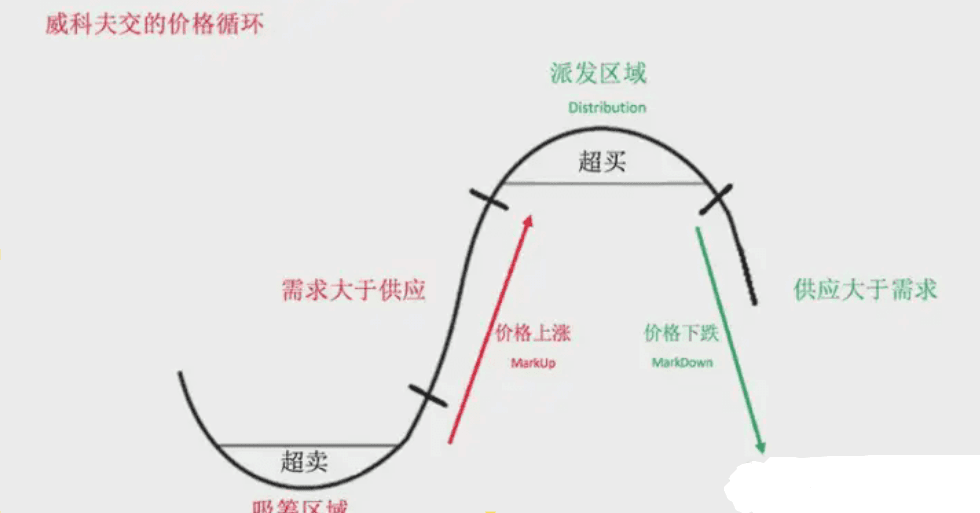
In the following text, we will analyze the practical application scenarios of Wyckoff theory through specific chart cases.
The buying and selling behavior of institutional funds
The most critical participants in the market are the so-called 'big funds'. These big players include central banks, hedge funds, commercial banks, and government agencies. They are the true driving force behind market movements.
These market participants cannot establish positions all at once and need to gradually build them through careful positioning. This process usually occurs during the accumulation and distribution phases: they need to cautiously clear existing positions before slowly constructing new ones. For these institutions, it is crucial to avoid the price deviating from the target range too early before fully establishing their positions.
For retail traders, a wise approach is to avoid participating in the horizontal volatility during the accumulation and distribution phases, patiently waiting for breakout signals or retracement opportunities.
Retail traders often chase prices too aggressively and usually enter trends too late. Most trading articles promote 'trend following' as an 'easy way to profit', leading ordinary traders to wait until trends are clear before taking action. However, a more efficient strategy is to enter trends near large capital accumulation areas.
This is precisely why we insist on and impart breakthrough trading and pullback trading strategies. Traditional trend-following methods often yield poor results.
Wyckoff Learning #1: Backtesting
When I study trading concepts or share my strategies, I mainly focus on those non-textbook-style formations. Price movements rarely develop according to the perfect patterns in textbooks, so being exposed to various chart cases can be very helpful for actual trading.
The screenshot below shows a perfect downtrend—accumulation—inducing a rebound (Spring) pattern.
At the bottom, the price briefly breaks below the previous low but does not continue the downtrend. Note that the bearish K-line during this potential 'false breakdown' is very small and lacks persuasion, while the subsequent bullish K-line is stronger and has a longer body. This already suggests that this attempt to break down is very weak.
Then the price broke out and rose for a while, before starting to pull back. Many traders will enter the market during the breakout and move their stop-loss to the breakeven point. This behavior is very common in the market, so we often see pullbacks occur. This pullback accurately hit the previous breakout point, triggering all stop-loss orders while also providing an opportunity to buy again at a lower position.
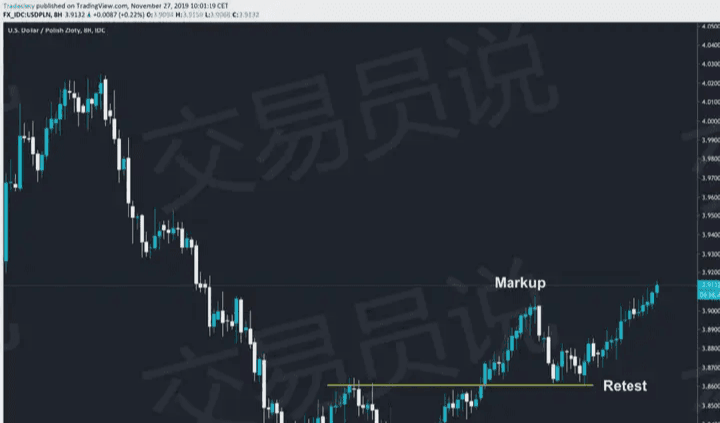
Price action before the breakout
Although this analysis is somewhat off-topic, it is definitely worth a look. Before the price truly breaks through the accumulation/distribution range, a special retracement structure often forms, which I call 'Lower-Bounce'.
Ask yourself again, what does this reveal about the comparison of bullish and bearish forces:
In a volatile range, bears have significantly pressured the price down to the support level (as seen with the large bearish candlestick). Then bulls attempt to enter and push the price higher, but fail; the price does not even approach the previous high. This is a very critical signal indicating that the market is still dominated by bears. Therefore, the subsequent bearish breakout is a logical outcome.
You will find that this pattern often appears before many successful breakouts, so you may want to consider this 'low-level rebound' as a resonating factor in your trading considerations.
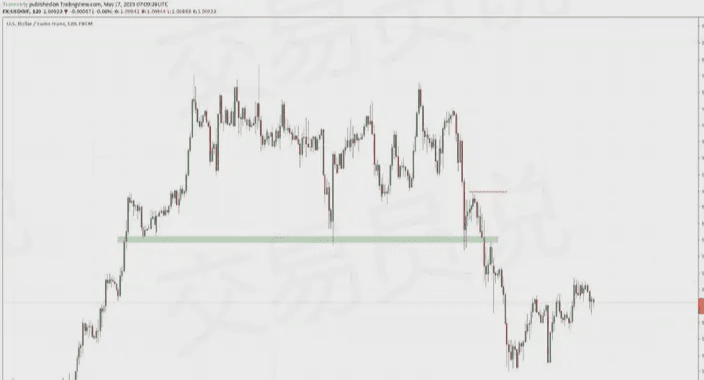 Wyckoff Learning 2: Confirmation
Wyckoff Learning 2: Confirmation
Sometimes, the 'spring effect' may appear in the form of a single pin bar. The key point is that this 'spring' must break below the previous low to fully confirm it as a failed breakout attempt.
As shown in the chart, the accumulation phase forms in a clearly defined horizontal range, with horizontal resistance levels. Before the official breakout, the price has begun to construct higher lows; this bullish resonance signal is particularly important, especially when it appears after the spring effect, further indicating that buying pressure is accumulating.
In this example, the backtest emerges immediately, revealing once again why the 'capital protection stop-loss' strategy is not the optimal choice. Although traders believe such stop-losses can 'protect' positions, in most cases, they make holdings weak during price pullbacks.
Once the pullback is confirmed, the price immediately enters the rally phase.
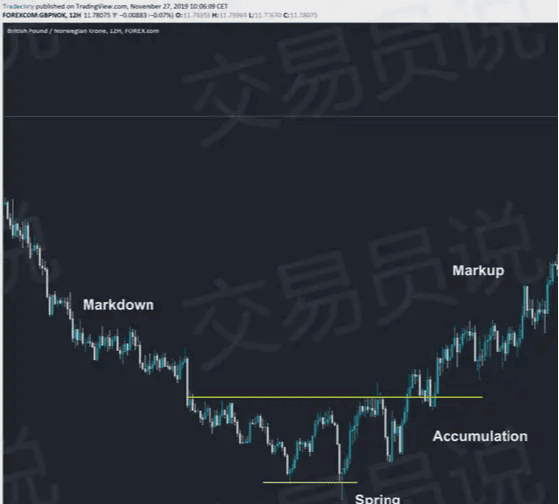
Wyckoff Learning 3: Non-textbook-style Accumulation and Distribution
Let's continue discussing those non-textbook-style accumulation and distribution phases.
In the left side of the chart below, the price did not form a long-term horizontal accumulation area, but we can clearly observe that the price stagnated after a downtrend. Moreover, before accumulation began, the price did not show a significant strong decline but rather a slow descent. This already suggests that this round of downtrend is not strong. If a reversal occurs after a weaker downtrend, the new round of uptrend is usually stronger.
The spring pattern is also very strong, further indicating that market forces are about to change. After the spring broke below fails, a very strong bullish K-line appears.
So far, we have found multiple resonance signals indicating that the upcoming bullish trend may succeed. Trade confidently with such a system; layering these resonance factors is very important. The more hints we can find, the stronger our confidence in trading.
After the breakout, the market immediately retraced and formed a backtest pattern. This is a very important market formation worthy of deep study.
In the right chart, you can see one of my ongoing trades (as of the publication of this article, this trade has reached its profit target). I traded based on the breakout from the distribution area. This 'spring' is a pin bar candlestick that has broken through all previous highs. This distribution area is defined by a very clear horizontal support level. Compared to trendlines, horizontal support levels require less subjective judgment, making timing for trades easier.
This breakout is also accompanied by a backtest.
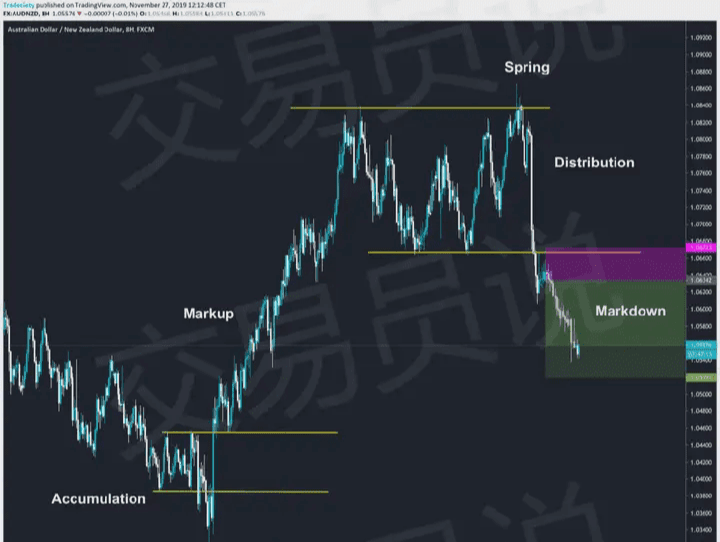 Wyckoff Learning 4: Wyckoff and Divergence Signals
Wyckoff Learning 4: Wyckoff and Divergence Signals
Divergence is an excellent trading analysis tool, perfectly fitting with Wyckoff theory and trend analysis. Although I have discussed divergences multiple times, simply put, divergence indicates that the momentum of the current trend is waning.
As we have seen in previous chart studies, the core of Wyckoff trend analysis is to interpret trend structures and trend strengths.
In the following scenario, the distribution phase occurs when the RSI indicator shows divergence. Although this distribution is not a perfect horizontal consolidation pattern, we can clearly see that the uptrend is losing momentum. Trend waves gradually shorten, and the price struggles to make new highs. At the top, the spring pattern manifests as a failed breakout, followed by a rapid downward price reversal.
After the spring, bearish K-lines suddenly become strong and significantly elongated, further confirming the shift in bullish and bearish forces. The bears are clearly ready to take over the market.
The downtrend phase (Markdown) did not achieve success immediately, but the price again retraced to the breakout area.
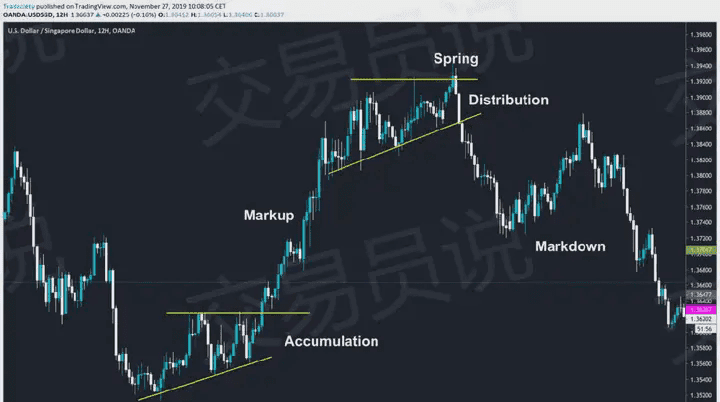 Wyckoff Learning 5: The collaborative application of spring patterns and Bollinger Bands
Wyckoff Learning 5: The collaborative application of spring patterns and Bollinger Bands
When identifying important spring patterns, Bollinger Bands are an excellent tool. Bollinger Bands essentially measure price volatility as a standard deviation indicator, meaning that when the price breaks through the outer Bollinger Band, it often indicates a significant market event. 95% to 99% of price fluctuations occur within the Bollinger Band channel.
If the price can significantly break through the outer Bollinger Bands, it will be more meaningful. Special attention should be given when the price significantly crosses the outer Bollinger Band. In the example below, the 'spring' on the left shows a very strong spike breaking through the Bollinger Band. We have discussed this type of chart situation above, but in conjunction with Bollinger Bands, we can treat it as another resonating factor in our toolbox.
The stronger the breakout amplitude (spike), the higher the actual reversal probability if all other resonance factors confirm the trend analysis.
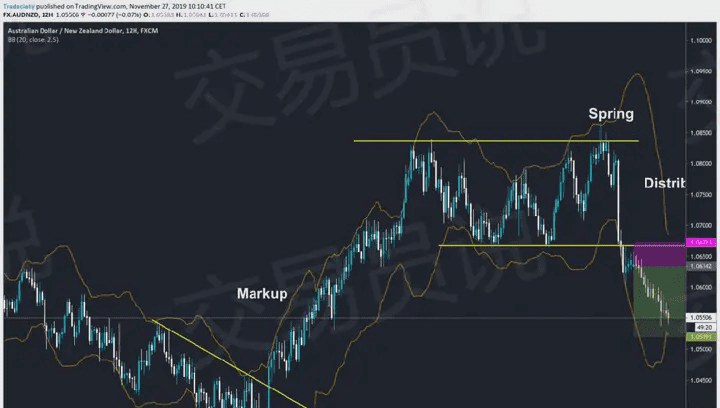
Finally, I want to emphasize that relying solely on Wyckoff analysis in trading may not be the most accurate method, but it provides a solid foundation for any chart analysis.
Technical Summary
A carefully designed trading plan that seamlessly integrates the Wyckoff method can be productive for the right trader. However, it must be emphasized to less experienced traders that this is a very complex process that requires a lot of time to master.
Wyckoff's market theory is based on analyzing the market from the perspective of institutional investors. Traders must consider the ultimate goals of these institutions and how current market behavior reflects their interests and actions.
Even today, many professional traders still use the Wyckoff method. His stock selection and investment approach have stood the test of time, primarily because it identifies the fundamental, systematic, and logical structures of high-probability, high-profit trades.
Wyckoff established some key principles in the early 20th century, such as trends, stop-losses, and profit-taking.
Even 100 years later, these timeless concepts continue to educate traders and investors.
Let us delve into the survival strategies in the crypto world, from novice beginners to seasoned players, from cognition to practice, comprehensively analyzing how to stand firm in this ever-changing field.
Part One: Survival Rules for Crypto Newbies
Entry-level Recognition - Blockchain
The cornerstone of the world.
When entering the crypto world for the first time, the primary task is to build a clear cognitive system. Blockchain, this distributed ledger technology, is the underlying logic of the entire cryptocurrency world. Bitcoin, as digital gold, is highly regarded for its scarcity and decentralization; Ethereum serves as the operating system in the blockchain field, with widespread applications of smart contracts expanding the boundaries of blockchain; stablecoins like Tether, linked to fiat currencies, have become important mediums in trading.
For novices, do not blindly follow the trend to chase so-called 'air coins'. These cryptocurrencies lacking actual value support have a high risk of going to zero. Remember, your funds are hard-earned; every investment decision should be based on thorough understanding.
Safety Line: Protecting the lifeline of digital assets
In the crypto world, safety awareness is like a fuse, constantly safeguarding your asset security. Cryptocurrency wallets are places to store assets, and the safekeeping of private keys or recovery phrases is crucial. Manually write down and store them properly, avoiding taking photos or disclosing them casually; this is the first step to prevent hacking.
The choice of exchange is also critical. Prioritize large exchanges with a good industry reputation and stable operations, such as Binance, OKX, etc. They have advantages in terms of security, trading depth, and user experience. Be wary of those so-called high-return exchanges that may be scams.
Investment minefields: Avoid high-risk traps
Contract trading is like high-stakes gambling in a casino; the high risks brought by high leverage can lead to instant liquidation for novices. Data shows that the average survival period for novices in contract trading is only 37 days. Therefore, investors lacking experience and expertise should avoid easily stepping into contract trading and instead focus on spot investments in mainstream cryptocurrencies like Bitcoin and Ethereum.
Furthermore, those 'funding coin' schemes that rely on referral models may appear to yield enticing short-term returns, but are essentially a mirage. Once market sentiment shifts or project leaders abscond with funds, investors face the risk of total loss. In the crypto world, maintaining rationality and independent thinking, avoiding being misled by superficial prosperity, is key to long-term survival.
Part Two: Military Rules for Cryptocurrency Investment
Cognitive Level: See the world clearly, seize opportunities
The cryptocurrency market is a battleground among retail investors, manipulators, institutions, and exchanges. You can only earn money within your cognitive range; profits derived from luck will ultimately be consumed by losses due to lack of skill. Believe in yourself, but this confidence should be built on continuous learning and cognitive enhancement, rather than blind arrogance.
In an era of information explosion, being wary of the reliability of information is crucial. Whether it's platform recommendations, KOL analyses, or insider information from big accounts, all need to be filtered and verified by oneself. Learn to analyze information independently to avoid becoming a pawn in others' interest chains.
Time and Energy: The core of investment productivity
In the crypto world, time and energy are the most valuable resources. Rather than spending time on pointless debates, it is better to invest energy in high-value learning and practice. Read whitepapers to deeply understand the underlying technology and business logic of projects; experience DeFi, NFTs, and other projects to feel their actual functions and application scenarios; learn valuable knowledge to enhance your professional skills; record your investment decision-making processes, summarize experiences and lessons to maintain rationality and professionalism in investing.
Narratives and Cycles: Capturing the pulse of the market
The cryptocurrency market is driven by narratives, and price fluctuations often reflect the market's expectations for the future. For instance, the rise of Dogecoin relies on community and KOL promotion; Bitcoin's strategic reserve narrative may support its long-term value. Investors need to understand the logic behind these narratives and assess their sustainability.
Grasping market cycles is equally critical. Bull market peaks are often accompanied by the apex of FOMO sentiment, at which point one should consider reducing positions; conversely, during market panic, it may be an excellent opportunity to position oneself. Learning to adjust investment strategies in different cycle stages is key to navigating the market smoothly.
Risk and Growth: Moving forward through attempts.
The high-risk nature of the cryptocurrency market requires investors to possess strong stress resistance and learning ability. Start with low-cost attempts, gradually accumulate experience. Learn to analyze on-chain data to gain insights into the real market dynamics, rather than merely relying on superficial data from exchanges.
Long-term vision: Planning a wealth blueprint
Formulating a trading plan and strictly executing it is a common trait of successful investors. Clearly define your investment goals, break them down into achievable, manageable tasks. Before achieving stable profits, do not easily quit your job to devote yourself full-time to the crypto world. At the same time, continuous learning is key to adapting to market changes and safeguarding wealth.
Part Three: Nine Don'ts for Traders
Confidentiality Principle: The wisdom of acting low-key.
After achieving financial freedom, maintaining a low profile is a strategy to protect oneself. Avoid revealing your trading experiences to those around you; do not post profit charts or asset pictures on social platforms. Displaying wealth can easily attract unnecessary attention and troubles, even leading to jealousy and potential danger.
Interpersonal Relationships: The necessity of reshaping social circles.
Many traders who achieved financial freedom in a bull market choose to distance themselves from their past social circles. This is because different life stages and wealth statuses dictate differences in social needs and values. Interacting with those who can understand and support you helps maintain good interpersonal relationships, avoiding conflicts and misunderstandings arising from wealth disparities.
Life attitude: Stay away from negative temptations
Gambling and drugs are black holes that consume wealth and life. The impulse to gamble and the harm of drugs can erode a person's will and body, turning rational investment decisions into chaos. Staying away from these negative temptations and maintaining physical and mental health is a prerequisite for enjoying financial freedom.
Emotional Management: Avoid impulsive decisions
In the process of trading coins, avoid verbal conflicts and maintain a friendly demeanor. Anger not only drains energy but may also affect your financial luck. Decisively distance yourself from those who bring negative influences, learn to manage emotions, and face market fluctuations with a calm mindset. At the same time, do not easily engage in unsolicited kindness; avoid excessive pity for others, and focus on your own growth and development.
Investment Strategy: Refuse blind expansion
Achieving success in familiar cryptocurrency fields does not imply that the same achievement can be easily replicated in other areas. Do not blindly invest in unfamiliar fields, as cognitive limitations may lead to financial losses. Additionally, starting a physical business in the current economic environment carries significant risks; unless you see it purely as a hobby, proceed with caution.
The crypto world is a realm full of opportunities and challenges, attracting countless people to engage. Whether a novice or an experienced investor, one must always maintain a clear mind, adhere to scientific investment methods and strategies. Through continuous learning, cautious operations, and effective risk management, you can navigate the complex and ever-changing cryptocurrency market steadily, achieving wealth accumulation and growth.
These experiences are what I have summarized in actual trading, playing a key role in cultivating the correct trading mindset and way of thinking. I hope that by sharing these experiences, I can help more novice traders who have just stepped into the trading door or traders battling in the market achieve better trading performance and reduce unnecessary troubles.
The old trader only does real trading; the team still has positions available.